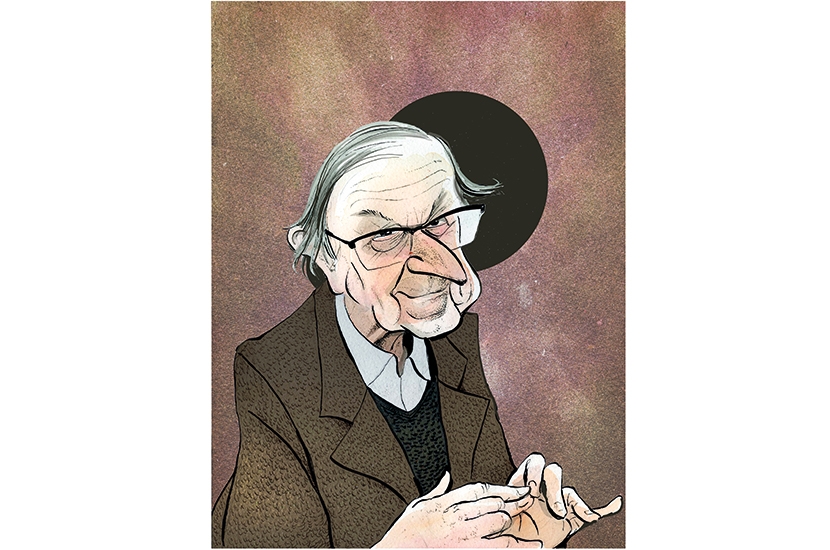Sir Roger Penrose was at school when he realized that his mind worked in an unusual way.
‘I thought, maybe when I go to university, I’ll find people who think like me,’ he tells me, at the beginning of what was to be a fascinating conversation, stretching long into the afternoon. ‘But it wasn’t like that at all. When I would talk to someone about an idea, I found myself not understanding a word they were saying.’
Just after we spoke, in early December, Penrose received the Nobel Prize in Physics, so perhaps it’s no surprise that he should think a little differently. But, as he explained it to me, his mind is unusually visual. Penrose’s father Lionel was an artist as well as a psychiatrist and mathematician, and a great influence on Roger. Father and son used to go for long walks together in search of things to draw. ‘I liked to do realistic pictures, but sometimes I would branch out and do more surrealistic things. I would fill my notebooks with all sorts of distorted pictures and interlocking faces and goodness knows what,’ says Penrose. But this meant trouble in exams. ‘If you’re doing algebra, you just write down the answer. But for geometric or visual work, you have to translate it into words. That takes time. Often the visual people literally don’t finish the papers. The result is that algebraic people do better in exams, so you find more of them at universities.’ On the upside, the tendency to work through mathematics with the aid of a mental image has contributed to some of his most important breakthroughs, including his Nobel-winning work on black holes.
The term ‘black hole’ refers to a massive object that warps space-time to the extent that nothing, not even light, can escape. At its center is a point called a singularity, where the density is infinite and physics itself breaks down. The existence of singularities and black holes had originally been derived from Einstein’s theory of general relativity, but in the 1960s many physicists still dismissed the idea. Penrose ultimately showed that singularities are inevitable, with the implication that black holes are common in the universe.
‘Some of the ideas came from a walk in the woods, where I imagined myself in a black hole, as we now call it, collapsing,’ said Penrose. ‘I was thinking about when the density gets big and wondering under what criterion it got too big. And I realized that it couldn’t be a local criterion. It must be something non-local.’ Penrose’s insight was that, to understand black holes, he had to consider the large-scale connections of space-time, rather than relying on information near the observer.
‘An even more important moment came when I was talking to a colleague while walking to my office. We came to a side street and as we crossed it our conversation stopped. Then we got to the other side and we started talking again.’ When he reached his office, Penrose felt in high spirits, but he couldn’t work out why. ‘I felt great about something. I tried to work through everything that had happened to me during the day. What did I have for breakfast? No, it wasn’t that. What was it? Then it came to me.’
Penrose remembered that he had been speaking with his colleague about ‘trapped surfaces’, on which all light rays converge. Using trapped surfaces, he was able to show that hidden behind every black hole must lie a singularity. The brilliance of Penrose’s argument was that you don’t need to know much about the details of the problem to get the conclusion of a singularity, just the existence of a trapped surface.
With characteristic modesty, however, Penrose suggests that the committee in Stockholm may have jumped the gun. ‘I never proved black holes could be there, generically. What I proved was that singularities had to be there.’
Cosmology is just one of Penrose’s interests. He has also thought deeply about consciousness and a lot of hype about AI flying around these days, including the recent report that scientists at DeepMind have used it to ‘solve’ protein folding. Yet for decades, Penrose has been consistent in his skepticism about the grand claims made for AI’s potential.
He mentions The Imitation Game, the movie about Alan Turing’s wartime codebreaking at Bletchley Park. The film’s name refers to a test of artificial intelligence developed by Turing. A computer and a person are concealed behind a screen and a third party offers written questions to each in an attempt to judge from their answers which one of them is human. Penrose took this test twice, and says the computer was hopeless. ‘The first time I sort of gave up, because the computer really had no conception of what I was trying to say. The second time, I said, “I believe we’ve met before”. Complete blank.’
Nevertheless, others are not so sure that humans will continue to have the upper hand. In 2015, Stephen Hawking, Elon Musk and others signed the Open Letter on Artificial Intelligence, calling for research into the potentially catastrophic consequences of the so-called technological singularity. This refers to the moment when machines will achieve artificial general intelligence. According to Terminator 2: Judgment Day, this was going to happen on August 29, 1997, when Skynet — an artificial neural network capable of rapid learning — would become self-aware.
Penrose doubts it will ever happen. ‘In any case, I think we’ve already passed the singular moments most experts were predicting, right? They keep pushing it to later!’ His big concern about AI isn’t Judgment Day, but rather ‘that people will believe machines actually understand things’. He gives examples of symmetrical chess configurations in which humans consistently outperform computers by abstracting to a higher level in which a proof of a draw becomes clear. This abstraction to different levels is key to scientific research. The inability of machines to abstract in this way doesn’t bode well for the prospect of their surprising us with original insights.
Penrose’s book Shadows of the Mind — a grand tour of computation, consciousness, algorithms, quantum theory and the brain — is, for me, still the most thrilling introduction to AI and its limits. It isn’t only the clarity of Penrose’s explanations that makes it compelling. There’s a restless curiosity running throughout the book which I believe is essential to creativity.
One of the paradoxes of research is that, time and again, the most far-reaching discoveries are made not by focusing on the practical problems of the day but by following your curiosity. Put another way, when your work, and what you do to avoid it, become the same thing, that’s when the breakthroughs come. Penrose tells a story that illustrates this perfectly. ‘Someone had invited me to give a talk at London South Bank University and I was really overdue with my reply. Instead of replying, all I could do was stare at the university logo on the letterhead: a pentagon with five pentagons around it.’ What bothered Penrose was that there were gaps between the external pentagons. Unlike hexagons, pentagons don’t fit together seamlessly.
He began wondering what new shapes would be required so he could fill in the gaps, and then extend the pattern without new gaps arising. It seemed it wasn’t possible with just one new shape. After a while, he had worked out a way to solve the puzzle using six new shapes. But Penrose wasn’t satisfied with six.
‘I thought, I wonder if I can do better? So I got it down to four tiles. And I was really proud of that. Then I fiddled around and I got it down to two. But my reaction was disappointment. It was just too damn easy. I felt it couldn’t be new.’
But it turned out the result of his labors, known as ‘Penrose tiling’, was new. It also has a mathematical and aesthetic beauty that interconnect in intricate ways, with deep links to the structure of quasicrystals and the theory of computation. Penrose tiling decorates the floor of the entrance hall at the London Institute for Mathematical Sciences where I work.
The easiest way to catch a glimpse of the way Penrose’s mind works is to look at his collaboration with the Dutch artist M.C. Escher. Back in the 1950s, Penrose happened to attend an Escher exhibition in Amsterdam, where he was ‘totally stunned’ by the visual paradoxes he saw. He was especially struck by an image called ‘Relativity’, which showed a staircase with gravity going in three directions and people going upstairs yet at right angles to each other.
But being Roger Penrose, he felt there was more that could be done with the idea. ‘I tried to draw rivers and bridges and things going this way and that in an impossible way. Then I simplified it down to this thing called the tribar, which is these three rods at right angles to each other, making a triangular configuration.’
Penrose collaborated with his father on teasing out manifestations of the paradox and between them they came up with the idea of an eternal staircase, and drew a version of it, known as the Penrose stairs. After publishing their concept, they sent a copy of the paper to Escher who, in turn, used the Penrose stairs as the inspiration for one of his best-known works, which he called ‘Ascending and Descending’. Penrose is currently working on a book inspired by Escher’s paradoxes — just one of three books in progress, it turns out.
***
Get a print and digital subscription to The Spectator.
Try a month free, then just $7.99 a month
***
The running theme in my interview with Penrose is his artistry, which is at the heart of his broad and deep insights into physics. I put it to him that one of the great mysteries of physics is that the laws describing the universe have such inherent beauty. So much so, in fact, that this same beauty is often used as a guide to discerning which laws are true. Penrose largely agrees, but distinguishes between different types of beauty. ‘There is a beauty in mathematics, which is different from the beauty in physics. They’re not quite the same.’ Einstein, he tells me, was incomparably gifted when it came to the beauty in physics, but less so at teasing out the mathematical beauty contained within his equations.
The original plan was that I would speak to Penrose for an hour. After two and a half hours, the sun has gone down and we’re still talking. As we draw to a close, I ask him something that often occupies my mind: do the wonders of physics and the beauty of its laws inspire belief in something that is beyond science? I’m not quite asking him if he believes in God, but nearly.
Sir Roger Penrose responds as gamely as he has to every other question I’ve put to him. ‘There is a sense in which I would say I’m an agnostic. I certainly don’t believe in Christianity. Maybe Jesus did a lot of the things described in the Bible, but certainly not all of them. But that doesn’t mean I’m an atheist. Do I believe in something outside science? Well, it’s a bit hard to know. What is science? Where are its boundaries? Is there something going on in consciousness, which is outside of science? Well, I like not to think that. It is certainly outside the science we have now. But it’s something we can explore scientifically. Whether we will have an understanding of what’s going on, which is deep enough to solve the mystery of what it is to be, I don’t know.’
Dr Thomas Fink is the director of the London Institute for Mathematical Sciences. This article was originally published in The Spectator’s UK magazine. Subscribe to the US edition here.


















